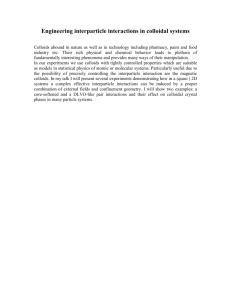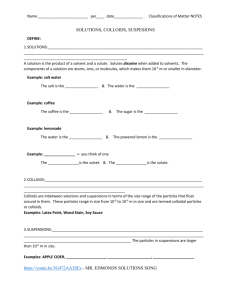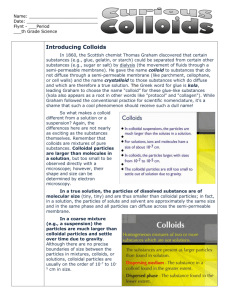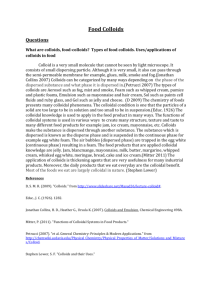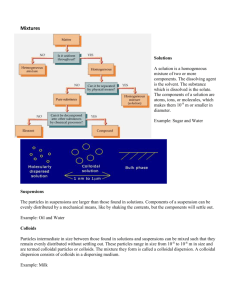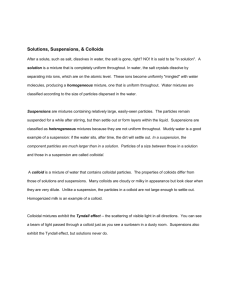Dispersed Systems
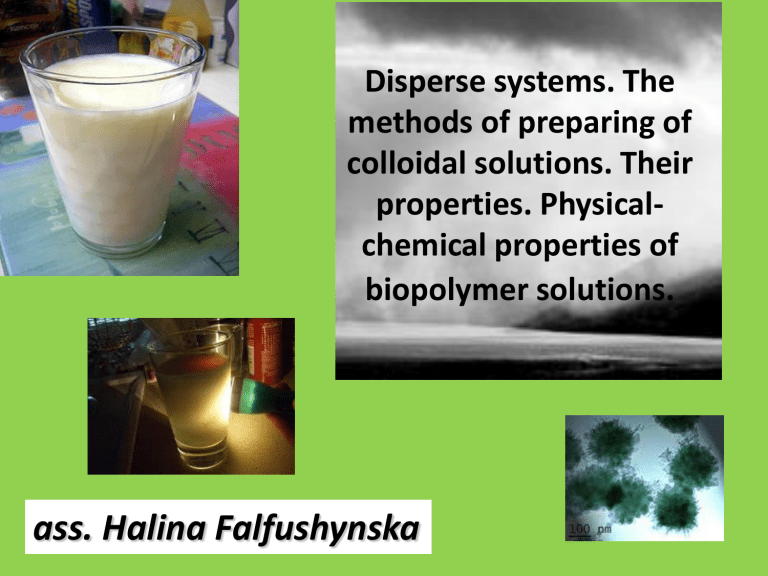
Disperse systems. The methods of preparing of colloidal solutions. Their properties. Physicalchemical properties of biopolymer solutions.
ass. Halina Falfushynska
Dispersed Systems
A kinetically stable mixture of one phase in another largely immiscible phase. Usually at least one length scale is in the colloidal range.
Dispersed Systems
Dispersed phase
Continuous phase
Interface
Classification of dispersed system in agreement with particles scale
Molecular dispersions is a true solutions of a solute phase in a solvent. The dispersed phase (solute) is in form of separate molecules homogeneously distributed throughout the dispersion medium(solvent). The molecule size is less than 1 nm (4*10 -8 inch). [The examples : air (a molecular mixture of Oxygen, Nitrogen and some other gases), electrolytes (aqueous solutions of salts)].
Colloids are micro-heterogeneous dispersed systems, in which the size of the dispersed phase particles is within the range 1 - 1000 nm (4*10 -8 - 4*10 -5 inch). The colloids phases can not be separated under gravity, centrifugal or other forces.
Dispersed phase of colloids may be separated from the dispersion medium by microfiltration. The examples of colloids: milk (emulsion of fat and some other substances in water), fog (aerosol of water micro-droplets in air), opal (colloidal silica), Silica aerogel monolith, Alumina aerogel monolith].
Coarse dispersions (suspensions) are heterogeneous dispersed systems, in which the dispersed phase particles are larger than 1000 nm (4*10 -5 “). Coarse dispersions are characterized by relatively fast sedimentation of the dispersed phase caused by gravity or other forces. Dispersed phase of coarse dispersions may be easily separated from the continuous phase by filtration.
http://www.youtube.com/watch?v=q96ljVMHYLo
• Lyophobic colloids consist of the phases, which do not interact between each other.
Dispersed phase in lyophobic colloids is not solvated by the dispersion media.
• Lyophobic colloids are prepared by mechanical agitation, which is required because of high interfacial energy of the dispersed particles.
• Lyophobic colloids are thermodynamically unstable. Their dispersed particles have a tendency to aggregation or coalescence.
Thermodynamic stability of lyophobic colloids may be
increased by an addition of relatively small amount of surface active substances (surfacants) lowering the interfacial energy of the system.
Some of lyophobic colloids possess lyophilic properties (eg. hydrosols of silica and alumina).
http://www.youtube.com/watch?v=-jZyqqN4uqc&feature=related
Classification of Colloids Based on Type of Particles of the Dispersed Phase
• Multimolecular colloids In this type of colloids the colloidal particles are aggregates of atoms or small molecules with molecular size less than one nanometer (1 nm). For e.g., gold sol consists of particles of various sizes which are clusters of several gold atoms. The molecules in the aggregates are held together by Van der Waal forces.
• Macromolecular colloids Macromolecular colloidal particles are formed when on dissolution in a suitable solvent, the macromolecules have sizes which are in the colloidal range. Naturally occurring macromolecules are starch, proteins and cellulose. Man made macromolecules are polymers such as polyethylene, nylon and polystyrene.
• Associated colloids (Micelles) Certain substances behave as strong electrolytes at low concentration but at higher concentrations these substances exhibit colloidal characteristics due to the formation of aggregated particles. These aggregated particles are called micelles. The formation of micelles takes place only above a particular temperature called Kraft Temperature (T k
) and above particular concentration called the Critical micelle concentration (CMC). On dilution, these colloids revert back to individual ions.
Interaction between colloid particles
• The following forces play an important role in the interaction of colloid particles:
• Electrostatic interaction : Colloidal particles often carry an electrical charge and therefore attract or repel each other. The charge of both the continuous and the dispersed phase, as well as the mobility of the phases are factors affecting this interaction.
• van der Waals forces : This is due to interaction between two dipoles that are either permanent or induced. Even if the particles do not have a permanent dipole, fluctuations of the electron density gives rise to a temporary dipole in a particle. This temporary dipole induces a dipole in particles nearby. The temporary dipole and the induced dipoles are then attracted to each other. This is known as van der Waals force, and is always present (unless the refractive indexes of the dispersed and continuous phases are matched), is short-range, and is attractive.
Interaction between colloid particles
• Entropic forces : According to the second law of thermodynamics, a system progresses to a state in which entropy is maximized. This can result in effective forces even between hard spheres.
• Steric forces between polymer-covered surfaces or in solutions containing non-adsorbing polymer can modulate interparticle forces, producing an additional steric repulsive force
(which is predominantly entropic in origin) or an attractive depletion force between them.
http://www.youtube.com/watch?v=k5HMVIb4J7A&NR=1
Nobel Prize for
Chemistry for his work on the heterogeneous nature of colloidal solutions.
The Faraday-Tindall effect
The distilled solution of absent, solve by water in different ratio Crab nebulosity
Opal
Tooth opalescence
Light for the dental technician is essential, especially when it comes to aesthetics. In a healthy tooth light effects manifest themselves from inside. Separate layers of tissues react for the light at different angles.
Interestingly, the structure of dentin and enamel differently behave to the light. Especially noticeable light blue opalescent glow enamel
Preparation of Lyophilic Sols
• Since lyophilic sols are quite stable, they can be easily prepared by shaking the lyophilic substance with the dispersion medium.
• Examples are: Colloidal sols of gum, starch, gelatine and egg albumin.
Preparation of Lyophobic Sols
• Lyophobic sols are prepared by two methods. They are:
• 1) Condensation methods - In condensation methods particles of atomic or molecular size are induced to combine to form aggregates of colloidal dimensions. To achieve this, chemical as well as physical methods are employed.
• 2) Dispersion methods. - In dispersion methods, colloidal particles are obtained by breaking large particles of a substance in the presence of a dispersion medium. Since the sols formed are unstable, they are stabilized by adding stabilizing agents.
Condensation methods
• a) Chemical methods
• Colloidal sols can be prepared by chemical reactions, which involve double decomposition, oxidation, reduction and hydrolysis. Examples of sols made by these methods are given below:
• i) Double decomposition
• ii) Oxidation
• iii) Reduction
• iv) Hydrolysis b) Physical methods
Dispersion methods
• a) Mechanical dispersion In mechanical dispersion, the coarse suspension of the substance is ground in a colloid mill, a ball mill or an ultrasonic disintegrator. The colloid mill consists of two metal discs, close together and rotating at high speed (7000 revolutions per minute) in opposite directions. By the process of such grinding, the suspension particles are torn off to the colloidal sizes.
b) Electrical disintegration or Bredig's
Arc Method
• In this method, an electric arc is struck between electrodes of the metal immersed in the dispersion medium.
The intense heat produced by the arc vaporizes the metal, which then condenses to form particles of colloidal size. By this method, sols of metals such as gold, silver and platinum can be prepared.
Toothpaste is a colloid, because it's part solid
Toothpaste
and part liquid.
• A tooth paste composition comprising, in combination with a detergent base, a mixture of micronized colloidal silica gel and activated charcoal.
• The present invention discloses a nano colloidal silver toothpaste, firstly, the silver is used as electrode, and the colloidal silver particles are prepared by means of electric spark bombardment, then are directly added into the toothpaste.
Toothpaste ingredients typically consist of:
• Thickening agents or binders to stabilize the toothpaste formula. They include mineral colloids, natural gums, seaweed colloids or synthetic cellulose. Detergents to create foaming action. They include sodium lauryl sulfate, sodium N-Lauryl sarcosinate.
• Hydrocolloids and silicate cements are examples of dental colloids. A colloidal model for the nanostructure of hydrated cement paste was proposed by Jennings in 2000 and has been referred to as CM-I.
The C-S-H is modeled as a network of prismatic-shaped aggregates or particles referred to as ‘globules’ for consistency with the original model (CM-I). A schematic of the model is illustrated in
Fig. The particles have a least dimension of about 5 nm and the other dimensions vary from 30-60nm.The particles are depicted as having outer surface and internal porosity as well as interlayer space.
A micelle is an aggregate of surfactant molecules dispersed in a liquid colloid. A typical micelle in aqueous solution forms an aggregate with the hydrophilic "head" regions in contact with surrounding solvent, sequestering the hydrophobic single tail regions in the micelle centre.
Micelle
A normal phase
• Inverse micelles have micelle (oil-inthe head-groups at the water micelle) centre with the tails extending out (waterin-oil micelle).
• Micelles are approximately spherical in shape. Other phases, including shapes such as ellipsoids, cylinders, and bilayers are also possible. The shape and size of a micelle is a function of the molecular geometry of its surfactant molecules and solution conditions such as surfactant concentration, temperature, pH, and ionic strength.
The process of forming micellae is known as micellization
In medicine, dialysis (from Greek "dialusis", meaning dissolution, "dia", meaning through, and "lysis", meaning loosening) is a process for removing waste and excess water from the blood.
Dialysis works on the principles of the diffusion of solutes and ultrafiltration of fluid across a semi-permeable membrane.
Types of Emulsion
A fine dispersion of one liquid in a second, largely immiscible liquid. In foods the liquids are inevitably oil m m and an aqueous solution.
Oil-in-water emulsion
Water
Oil
Emulsions are an example of colloids composed of tiny particles suspended in another immiscible
(unmixable) material. Water-in-oil emulsion
Biopolymers
Biopolymers are polymers produced by living organisms. Since they are polymers, Biopolymers contain monomeric units that are covalently bonded to form larger structures. There are three main classes of biopolymers based on the differing monomeric units used and the structure of the biopolymer formed. Polynucleotides long polymers which are composed of 13 or more nucleotide monomers, Polypeptides short polymers of amino acids, and Polysaccharides which are often linear bonded polymeric carbohydrate structures.
Cellulose is the most common organic compound and biopolymer on Earth.
About 33 percent of all plant matter is cellulose. The cellulose content of cotton is 90 percent and that of wood is
50 percent.
Characteristics of biopolymer
Polymer samples usually are irregular in shape, making it difficult to measure their volume directly. The useful properties of polymer is density. The density can be used to calculate the percent of a polymer that is crystalline.
The tensile strength of a material quantifies how much stress the material will endure before suffering permanent deformation This is very important in applications that rely upon a polymer's physical strength or durability
Young's modulus of elasticity. Young's Modulus quantifies the elasticity of the polymer. It is defined, for small strains, as the ratio of rate of change of stress to strain. Like tensile strength, this is highly relevant in polymer applications involving the physical properties of polymers, such as rubber bands. The modulus is strongly dependent on temperature.
Transport properties such as diffusivity relate to how rapidly molecules move through the polymer matrix. These are very important in many applications of polymers for films and membranes.
Phase behavior a) Melting point
The term melting point, when applied to polymers, suggests not a solid-liquid phase transition but a transition from a crystalline or semi-crystalline phase to a solid amorphous phase. b) Glass transition temperature
A parameter of particular interest in synthetic polymer manufacturing is the glass transition temperature (T g
), which describes the temperature at which amorphous polymers undergo a transition from a rubbery, viscous amorphous liquid, to a brittle, glassy amorphous solid. The glass transition temperature may be engineered by altering the degree of branching or crosslinking in the polymer or by the addition of plasticizer.
Chemical properties
The attractive forces between polymer chains play a large part in determining a polymer's properties.
Because polymer chains are so long, these interchain forces are amplified far beyond the attractions between conventional molecules. Different side groups on the polymer can lend the polymer to ionic bonding or hydrogen bonding between its own chains. These stronger forces typically result in higher tensile strength and higher crystalline melting points.
